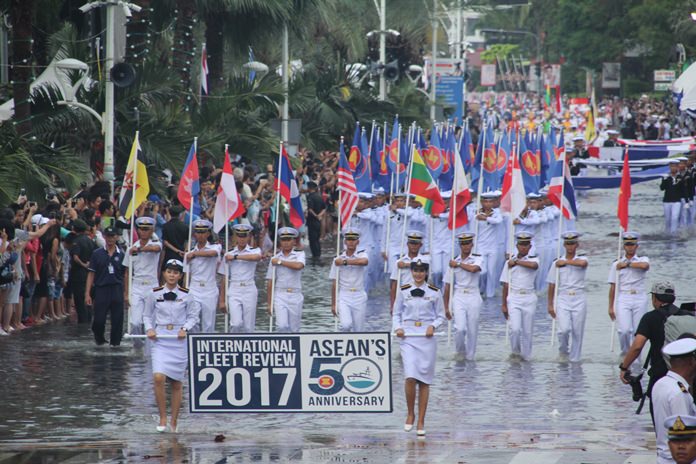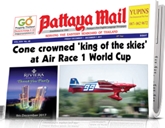
I am sure you must have seen that excellent piece of photo journalism on page 3 of the Pattaya Mail. The one with the visiting navies marching along Beach Road, but Beach Road was awash with water. About mid-calf deep.
 Without wishing to rain on anybody’s party, one gets the opinion that the organizers weren’t Boy Scouts. They weren’t ‘prepared’. It’s not as if it doesn’t rain at this time of year.
Without wishing to rain on anybody’s party, one gets the opinion that the organizers weren’t Boy Scouts. They weren’t ‘prepared’. It’s not as if it doesn’t rain at this time of year.
So what could have been done? Take the umbrellas that used to be on the beach and supply the troops? Or more practical have an alternate route with better drainage?
So if you were going to get some great shots in a torrential downpour, and there are great shots to be had in the wet environment, what should you do to be prepared? In other words, get your camera safe and water proofed and ready for the rain.
Now in the wet weather, being prepared means that not only do you have fresh batteries, a memory card with room for more shots, but also ensuring that your camera stays dry. This is not all that easy, unless you have an assistant with a large umbrella at your disposal.
Being prepared then means having your camera ‘waterproof’. To do this 100 percent you can buy a Nikonos underwater camera at the cost of many thousands of baht. These are a wonderful underwater camera but for this instance – totally impractical, unless you want to stand at the side of the road in a full wet-suit!
The second way is to purchase a fancy plastic underwater housing for your own camera. Now these can range in price, depending on complexity. Built like a perspex box to house your camera, you can operate all the adjustments from the outside. These are not cheap either, and the cheapest in the range is literally a plastic bag with a waterproof opening and a clear plastic section for the lens. You open it up and literally drop your camera inside it and seal the bag. These can be purchased from major photographic outlets and I did spot one in a photo-shop for B. 750.
A third way is a waterproof disposable camera (yes, they used to make them but they are film cameras). Good for about three meters, so perfectly suitable for rainstorms. If you can’t get one of those, then even the ordinary cheap disposables are a better option than getting your good camera gear doused. I must admit to having dropped one of these overboard one day and the boatman jumped and retrieved it and the final photos were fine – but that was in the days of film, and not fancy electronics.
But you are left with an even simpler way of making your camera waterproof. And cheaper. It consists of a couple of plastic bags, such as you get with every item in 7-Eleven, and a handful of rubber bands and a pair of scissors.
Do the camera body first, inserting it into the plastic bag, but leaving a circular hole in the front so you can screw the lens on afterwards. Some rubber bands and the body is protected.
Now pop the lens into the other plastic bag, making circular holes at both ends and fixing it in place with a couple of rubber bands. Use large bags, so there is slack to move the focusing ring/aperture settings. Make the outer lens hole a snug fit with your skylight 1A and rubber banded in place.
Your waterproof camera for less than one baht. Go out and get wet and shoot! But it is a simple case of being prepared and just jumping in to get some great shots, don’t stage manage, and lots of luck! Look out for photo opportunities, even when it is raining.
When it is raining, it really does mean another photographic opportunity to get different shots. Since we get bright sun for nine months a year, make the most of the rain!
It is a simple case of being prepared and then just jumping in to get the shots. And when you are back indoors dry the camera carefully as there is always some condensation.





